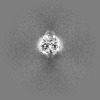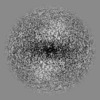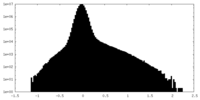+ Open data
Open data
- Basic information
Basic information
| Entry |  | |||||||||
|---|---|---|---|---|---|---|---|---|---|---|
| Title | Cyro-EM Structure of Human TLR4/MD-2/DLAM1 Complex | |||||||||
 Map data Map data | main map | |||||||||
 Sample Sample |
| |||||||||
 Keywords Keywords | Innate immune system / Toll-like receptors / TLR4 agonist / Vaccine adjuvants / Disaccharide-based Lipid A Mimetics / IMMUNE SYSTEM | |||||||||
| Function / homology |  Function and homology information Function and homology informationdetection of fungus / nitric oxide production involved in inflammatory response / MHC class II biosynthetic process / positive regulation of cellular response to macrophage colony-stimulating factor stimulus / lipopolysaccharide immune receptor activity / positive regulation of nucleotide-binding oligomerization domain containing 1 signaling pathway / positive regulation of matrix metallopeptidase secretion / Toll-like receptor 4 binding / detection of lipopolysaccharide / regulation of dendritic cell cytokine production ...detection of fungus / nitric oxide production involved in inflammatory response / MHC class II biosynthetic process / positive regulation of cellular response to macrophage colony-stimulating factor stimulus / lipopolysaccharide immune receptor activity / positive regulation of nucleotide-binding oligomerization domain containing 1 signaling pathway / positive regulation of matrix metallopeptidase secretion / Toll-like receptor 4 binding / detection of lipopolysaccharide / regulation of dendritic cell cytokine production / lipopolysaccharide receptor complex / MyD88-independent TLR4 cascade / negative regulation of interleukin-23 production / cellular response to oxidised low-density lipoprotein particle stimulus / TRIF-mediated programmed cell death / wound healing involved in inflammatory response / B cell proliferation involved in immune response / nucleotide-binding oligomerization domain containing 1 signaling pathway / positive regulation of nucleotide-binding oligomerization domain containing 2 signaling pathway / positive regulation of stress-activated MAPK cascade / Toll Like Receptor 4 (TLR4) Cascade / intestinal epithelial structure maintenance / Caspase activation via Death Receptors in the presence of ligand / positive regulation of interleukin-1 production / macrophage activation / astrocyte development / Regulation of TLR by endogenous ligand / TRIF-dependent toll-like receptor signaling pathway / microglia differentiation / nucleotide-binding oligomerization domain containing 2 signaling pathway / NAD+ nucleosidase activity, cyclic ADP-ribose generating / positive regulation of MHC class II biosynthetic process / positive regulation of macrophage activation / positive regulation of platelet activation / positive regulation of lipopolysaccharide-mediated signaling pathway / negative regulation of interleukin-17 production / MyD88 deficiency (TLR2/4) / positive regulation of cytokine production involved in inflammatory response / positive regulation of chemokine (C-X-C motif) ligand 2 production / positive regulation of extrinsic apoptotic signaling pathway / IRAK4 deficiency (TLR2/4) / negative regulation of cold-induced thermogenesis / positive regulation of macrophage cytokine production / positive regulation of smooth muscle cell migration / MyD88-dependent toll-like receptor signaling pathway / MyD88:MAL(TIRAP) cascade initiated on plasma membrane / T-helper 1 type immune response / toll-like receptor 4 signaling pathway / toll-like receptor signaling pathway / RSV-host interactions / positive regulation of NLRP3 inflammasome complex assembly / negative regulation of osteoclast differentiation / positive regulation of reactive oxygen species biosynthetic process / cellular response to lipoteichoic acid / negative regulation of interleukin-6 production / negative regulation of type II interferon production / Respiratory syncytial virus (RSV) attachment and entry / positive regulation of interferon-alpha production / positive regulation of interleukin-10 production / negative regulation of tumor necrosis factor production / phagocytosis / phagocytic cup / stress-activated MAPK cascade / positive regulation of chemokine production / JNK cascade / cellular response to platelet-derived growth factor stimulus / ruffle / positive regulation of B cell proliferation / ERK1 and ERK2 cascade / nitric oxide biosynthetic process / positive regulation of interleukin-12 production / Regulation of TBK1, IKKε (IKBKE)-mediated activation of IRF3, IRF7 / IRAK2 mediated activation of TAK1 complex upon TLR7/8 or 9 stimulation / positive regulation of smooth muscle cell proliferation / TRAF6-mediated induction of TAK1 complex within TLR4 complex / positive regulation of interferon-beta production / lipopolysaccharide-mediated signaling pathway / Activation of IRF3, IRF7 mediated by TBK1, IKKε (IKBKE) / IKK complex recruitment mediated by RIP1 / positive regulation of interleukin-1 beta production / positive regulation of interleukin-8 production / positive regulation of JNK cascade / lipopolysaccharide binding / Heme signaling / cellular response to mechanical stimulus / positive regulation of NF-kappaB transcription factor activity / negative regulation of ERK1 and ERK2 cascade / cellular response to type II interferon / positive regulation of interleukin-6 production / positive regulation of type II interferon production / cellular response to amyloid-beta / positive regulation of inflammatory response / positive regulation of nitric oxide biosynthetic process / positive regulation of tumor necrosis factor production / transmembrane signaling receptor activity / signaling receptor activity / amyloid-beta binding / ER-Phagosome pathway / cellular response to lipopolysaccharide / response to lipopolysaccharide Similarity search - Function | |||||||||
| Biological species |  Homo sapiens (human) Homo sapiens (human) | |||||||||
| Method | single particle reconstruction / cryo EM / Resolution: 2.7 Å | |||||||||
 Authors Authors | Fu Y / Kim H / Zamyatina A / Kim HM | |||||||||
| Funding support | 1 items
| |||||||||
 Citation Citation |  Journal: Nat Commun / Year: 2025 Journal: Nat Commun / Year: 2025Title: Structural insight into TLR4/MD-2 activation by synthetic LPS mimetics with distinct binding modes. Authors: Yaoyao Fu / Hyojin Kim / Dong Sun Lee / Ah-Reum Han / Holger Heine / Alla Zamyatina / Ho Min Kim /    Abstract: The mammalian pattern-recognition receptor TLR4/MD-2 (Toll-like receptor 4/myeloid differentiation factor-2) can be activated by a wide variety of pathogen-associated and endogenous molecules, with ...The mammalian pattern-recognition receptor TLR4/MD-2 (Toll-like receptor 4/myeloid differentiation factor-2) can be activated by a wide variety of pathogen-associated and endogenous molecules, with Gram-negative bacterial lipopolysaccharide (LPS) being the primary natural TLR4 agonist. Activation of TLR4 triggers cellular signaling that enables the beneficial innate immune responses and enhances adaptive immunity, thereby emphasizing the potential of TLR4 agonists for the management of diseases with an immunopathological background and for use as vaccine adjuvants. Given the challenges associated with LPS-derived products, including structural complexity, heterogeneity, toxicity, and species specificity, synthetic molecules targeting TLR4/MD-2 offer a promising alternative. Here, we elucidate the structural basis for the recognition of synthetic LPS-mimicking glycolipids, Disaccharide Lipid A Mimetics (DLAMs), by human and mouse TLR4/MD-2 through cryo-EM structures of six dimeric [TLR4/MD-2/ligand] complexes resolved at 2.2-3.1 Å. We reveal that the specific binding modes of DLAMs, distinct from those of LPS, are essential for the species-independent TLR4 agonistic activity. DLAMs function as a molecular bridge, effectively induce the dimerization of TLR4/MD-2 complexes through specific carbohydrate structure-relevant ligand-protein interactions. Our findings reveal the distinct molecular modes of TLR4 activation, and provide a structural basis for the rationale design and development of innovative, highly potent TLR4-targeting immunotherapeutics and adjuvants. | |||||||||
| History |
|
- Structure visualization
Structure visualization
| Supplemental images |
|---|
- Downloads & links
Downloads & links
-EMDB archive
| Map data |  emd_61047.map.gz emd_61047.map.gz | 122.3 MB |  EMDB map data format EMDB map data format | |
|---|---|---|---|---|
| Header (meta data) |  emd-61047-v30.xml emd-61047-v30.xml emd-61047.xml emd-61047.xml | 18.5 KB 18.5 KB | Display Display |  EMDB header EMDB header |
| FSC (resolution estimation) |  emd_61047_fsc.xml emd_61047_fsc.xml | 13.2 KB | Display |  FSC data file FSC data file |
| Images |  emd_61047.png emd_61047.png | 60.9 KB | ||
| Filedesc metadata |  emd-61047.cif.gz emd-61047.cif.gz | 6.7 KB | ||
| Others |  emd_61047_half_map_1.map.gz emd_61047_half_map_1.map.gz emd_61047_half_map_2.map.gz emd_61047_half_map_2.map.gz | 226.1 MB 226.1 MB | ||
| Archive directory |  http://ftp.pdbj.org/pub/emdb/structures/EMD-61047 http://ftp.pdbj.org/pub/emdb/structures/EMD-61047 ftp://ftp.pdbj.org/pub/emdb/structures/EMD-61047 ftp://ftp.pdbj.org/pub/emdb/structures/EMD-61047 | HTTPS FTP |
-Validation report
| Summary document |  emd_61047_validation.pdf.gz emd_61047_validation.pdf.gz | 866.2 KB | Display |  EMDB validaton report EMDB validaton report |
|---|---|---|---|---|
| Full document |  emd_61047_full_validation.pdf.gz emd_61047_full_validation.pdf.gz | 865.8 KB | Display | |
| Data in XML |  emd_61047_validation.xml.gz emd_61047_validation.xml.gz | 22.3 KB | Display | |
| Data in CIF |  emd_61047_validation.cif.gz emd_61047_validation.cif.gz | 28.5 KB | Display | |
| Arichive directory |  https://ftp.pdbj.org/pub/emdb/validation_reports/EMD-61047 https://ftp.pdbj.org/pub/emdb/validation_reports/EMD-61047 ftp://ftp.pdbj.org/pub/emdb/validation_reports/EMD-61047 ftp://ftp.pdbj.org/pub/emdb/validation_reports/EMD-61047 | HTTPS FTP |
-Related structure data
| Related structure data |  9j03MC 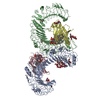 8wo1C  8wqtC  8wryC  8wsaC 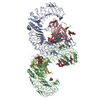 8wtaC M: atomic model generated by this map C: citing same article ( |
|---|---|
| Similar structure data | Similarity search - Function & homology  F&H Search F&H Search |
- Links
Links
| EMDB pages |  EMDB (EBI/PDBe) / EMDB (EBI/PDBe) /  EMDataResource EMDataResource |
|---|---|
| Related items in Molecule of the Month |
- Map
Map
| File |  Download / File: emd_61047.map.gz / Format: CCP4 / Size: 244.1 MB / Type: IMAGE STORED AS FLOATING POINT NUMBER (4 BYTES) Download / File: emd_61047.map.gz / Format: CCP4 / Size: 244.1 MB / Type: IMAGE STORED AS FLOATING POINT NUMBER (4 BYTES) | ||||||||||||||||||||||||||||||||||||
|---|---|---|---|---|---|---|---|---|---|---|---|---|---|---|---|---|---|---|---|---|---|---|---|---|---|---|---|---|---|---|---|---|---|---|---|---|---|
| Annotation | main map | ||||||||||||||||||||||||||||||||||||
| Projections & slices | Image control
Images are generated by Spider. | ||||||||||||||||||||||||||||||||||||
| Voxel size | X=Y=Z: 0.848 Å | ||||||||||||||||||||||||||||||||||||
| Density |
| ||||||||||||||||||||||||||||||||||||
| Symmetry | Space group: 1 | ||||||||||||||||||||||||||||||||||||
| Details | EMDB XML:
|
-Supplemental data
-Half map: half A
| File | emd_61047_half_map_1.map | ||||||||||||
|---|---|---|---|---|---|---|---|---|---|---|---|---|---|
| Annotation | half_A | ||||||||||||
| Projections & Slices |
| ||||||||||||
| Density Histograms |
-Half map: half B
| File | emd_61047_half_map_2.map | ||||||||||||
|---|---|---|---|---|---|---|---|---|---|---|---|---|---|
| Annotation | half_B | ||||||||||||
| Projections & Slices |
| ||||||||||||
| Density Histograms |
- Sample components
Sample components
-Entire : human TLR4/MD-2/DLAM1 complex
| Entire | Name: human TLR4/MD-2/DLAM1 complex |
|---|---|
| Components |
|
-Supramolecule #1: human TLR4/MD-2/DLAM1 complex
| Supramolecule | Name: human TLR4/MD-2/DLAM1 complex / type: complex / ID: 1 / Parent: 0 / Macromolecule list: #1-#2 |
|---|---|
| Source (natural) | Organism:  Homo sapiens (human) Homo sapiens (human) |
-Macromolecule #1: Lymphocyte antigen 96
| Macromolecule | Name: Lymphocyte antigen 96 / type: protein_or_peptide / ID: 1 / Number of copies: 2 / Enantiomer: LEVO |
|---|---|
| Source (natural) | Organism:  Homo sapiens (human) Homo sapiens (human) |
| Molecular weight | Theoretical: 16.385941 KDa |
| Recombinant expression | Organism:  Trichoplusia ni (cabbage looper) Trichoplusia ni (cabbage looper) |
| Sequence | String: QKQYWVCNSS DASISYTYCD KMQYPISINV NPCIELKGSK GLLHIFYIPR RDLKQLYFNL YITVNTMNLP KRKEVICRGS DDDYSFCRA LKGETVNTTI SFSFKGIKFS KGKYKCVVEA ISGSPEEMLF CLEFVILHQP NSN UniProtKB: Lymphocyte antigen 96 |
-Macromolecule #2: Toll-like receptor 4
| Macromolecule | Name: Toll-like receptor 4 / type: protein_or_peptide / ID: 2 / Number of copies: 2 / Enantiomer: LEVO |
|---|---|
| Source (natural) | Organism:  Homo sapiens (human) Homo sapiens (human) |
| Molecular weight | Theoretical: 68.838328 KDa |
| Recombinant expression | Organism:  Trichoplusia ni (cabbage looper) Trichoplusia ni (cabbage looper) |
| Sequence | String: EPCVEVVPNI TYQCMELNFY KIPDNLPFST KNLDLSFNPL RHLGSYSFFS FPELQVLDLS RCEIQTIEDG AYQSLSHLST LILTGNPIQ SLALGAFSGL SSLQKLVAVE TNLASLENFP IGHLKTLKEL NVAHNLIQSF KLPEYFSNLT NLEHLDLSSN K IQSIYCTD ...String: EPCVEVVPNI TYQCMELNFY KIPDNLPFST KNLDLSFNPL RHLGSYSFFS FPELQVLDLS RCEIQTIEDG AYQSLSHLST LILTGNPIQ SLALGAFSGL SSLQKLVAVE TNLASLENFP IGHLKTLKEL NVAHNLIQSF KLPEYFSNLT NLEHLDLSSN K IQSIYCTD LRVLHQMPLL NLSLDLSLNP MNFIQPGAFK EIRLHKLTLR NNFDSLNVMK TCIQGLAGLE VHRLVLGEFR NE GNLEKFD KSALEGLCNL TIEEFRLAYL DYYLDDIIDL FNCLTNVSSF SLVSVTIERV KDFSYNFGWQ HLELVNCKFG QFP TLKLKS LKRLTFTSNK GGNAFSEVDL PSLEFLDLSR NGLSFKGCCS QSDFGTTSLK YLDLSFNGVI TMSSNFLGLE QLEH LDFQH SNLKQMSEFS VFLSLRNLIY LDISHTHTRV AFNGIFNGLS SLEVLKMAGN SFQENFLPDI FTELRNLTFL DLSQC QLEQ LSPTAFNSLS SLQVLNMSHN NFFSLDTFPY KCLNSLQVLD YSLNHIMTSK KQELQHFPSS LAFLNLTQND FACTCE HQS FLQWIKDQRQ LLVEVERMEC ATPSDKQGMP VLSLNITCQM NK UniProtKB: Toll-like receptor 4 |
-Macromolecule #6: (3R)-3-(dodecanoyloxy)tetradecanoic acid
| Macromolecule | Name: (3R)-3-(dodecanoyloxy)tetradecanoic acid / type: ligand / ID: 6 / Number of copies: 6 / Formula: 2IL |
|---|---|
| Molecular weight | Theoretical: 426.673 Da |
| Chemical component information |  ChemComp-2IL: |
-Macromolecule #7: 2-acetamido-2-deoxy-beta-D-glucopyranose
| Macromolecule | Name: 2-acetamido-2-deoxy-beta-D-glucopyranose / type: ligand / ID: 7 / Number of copies: 6 / Formula: NAG |
|---|---|
| Molecular weight | Theoretical: 221.208 Da |
| Chemical component information | 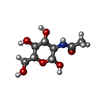 ChemComp-NAG: |
-Macromolecule #8: 2-amino-2-deoxy-4-O-phosphono-alpha-D-glucopyranose
| Macromolecule | Name: 2-amino-2-deoxy-4-O-phosphono-alpha-D-glucopyranose / type: ligand / ID: 8 / Number of copies: 2 / Formula: GP4 |
|---|---|
| Molecular weight | Theoretical: 259.151 Da |
| Chemical component information | 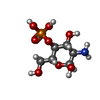 ChemComp-GP4: |
-Macromolecule #9: [(2~{R},3~{S},4~{S},5~{S})-5-methoxy-3,4,6-tris(oxidanyl)oxan-2-y...
| Macromolecule | Name: [(2~{R},3~{S},4~{S},5~{S})-5-methoxy-3,4,6-tris(oxidanyl)oxan-2-yl]methyl dihydrogen phosphate type: ligand / ID: 9 / Number of copies: 2 / Formula: X6Z |
|---|---|
| Molecular weight | Theoretical: 274.162 Da |
-Experimental details
-Structure determination
| Method | cryo EM |
|---|---|
 Processing Processing | single particle reconstruction |
| Aggregation state | particle |
- Sample preparation
Sample preparation
| Buffer | pH: 8 Component:
| |||||||||
|---|---|---|---|---|---|---|---|---|---|---|
| Grid | Model: Quantifoil R1.2/1.3 / Material: COPPER / Mesh: 300 / Pretreatment - Type: GLOW DISCHARGE / Pretreatment - Time: 5 sec. / Details: 10mA | |||||||||
| Vitrification | Cryogen name: ETHANE |
- Electron microscopy
Electron microscopy
| Microscope | TFS KRIOS |
|---|---|
| Image recording | Film or detector model: GATAN K3 BIOQUANTUM (6k x 4k) / Number grids imaged: 1 / Number real images: 13308 / Average electron dose: 67.8 e/Å2 |
| Electron beam | Acceleration voltage: 300 kV / Electron source:  FIELD EMISSION GUN FIELD EMISSION GUN |
| Electron optics | Calibrated magnification: 58962 / Illumination mode: FLOOD BEAM / Imaging mode: BRIGHT FIELD / Cs: 2.7 mm / Nominal defocus max: 1.7 µm / Nominal defocus min: 0.7000000000000001 µm / Nominal magnification: 105000 |
| Sample stage | Cooling holder cryogen: NITROGEN |
| Experimental equipment |  Model: Titan Krios / Image courtesy: FEI Company |
 Movie
Movie Controller
Controller




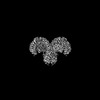






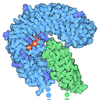

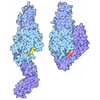

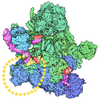
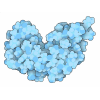

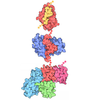

 Z (Sec.)
Z (Sec.) Y (Row.)
Y (Row.) X (Col.)
X (Col.)













